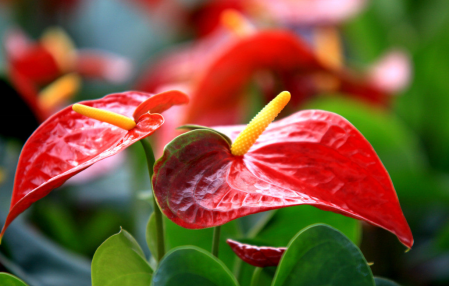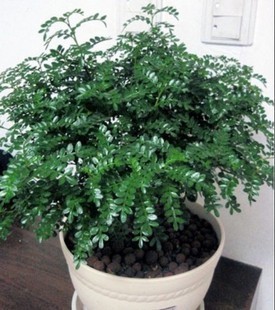How does Anthurium andraeanum leaves become brown and necrotic?
The causes of brown and necrotic leaves of Anthurium andraeanum seedlings do not rule out two possibilities:
First, bacteria | Leaf spot, waterlogged irregular brown to dark brown spots appear between leaf veins at the initial stage of infection, surrounded by yellow halos, and in severe cases, the disease spots merge into large spots, wilting and curling hanging on the short stem. Examination of dead and decaying tissue, if emitting an unpleasant fishy smell, accompanied by yellow bacterial pus, can be sure to be caused by bacterial damage.
Prevention and treatment: 72% of agricultural streptomycin sulfate soluble powder 4000 times or medical streptomycin sulfate 3000 times solution was used at the initial stage of the disease, and the plants were sprayed every 7 to 10 days.
Second, fungal black spot disease, often causing leaf tissue necrosis, wilting, decay and other symptoms, with the naked eye can be observed pathogens or their abnormal forms, such as small black spots, black mold, etc., generally slow development, mostly manifested as wet rot, no fishy smell.
Prevention and treatment: at the initial stage of the disease, 40% of ethyl aluminum and prohydantoin wettable powder can be sprayed with 400 times, or 45% of Dysenammonium 800 times, or 75% of 100. The germicidal efficacy of 1000 times liquid spray of bacteriophage wettable powder is good.
Preventive measures for yellowing of Anthurium andraeanum leaves
Anthurium andraeanum, also known as fire crane, red crane taro, red taro, lantern flower, andrographis andraeanum, is a perennial flower of Anthurium of Araceae. The tropical rain forest native to Central and South America has bright flowers, continuous blooming in four seasons, waxy outer cover and long shelf life. At first glance, it looks like an artificial fake flower with a strange and beautiful flower appearance. It is a famous species of potted and cut flowers, favored by the majority of consumers. However, in the process of cultivation, its growth is often poor and the leaves are yellowed due to a variety of factors.
1. Preventive measures: normal watering.
two。 Uneven fertilization: little fertilization, or no change of soil for a long time, lack of nitrogen and other nutrients in the soil lead to thin branches and leaves, thin and yellow leaves. In addition, excessive fertilization will also lead to the thickening and uneven of new leaves, and the dry tip and scorched yellow of old leaves will fall off at the same time. At this time, we should immediately stop fertilization, increase watering, remove part of the old soil, replace it with new culture soil, and carry out normal management.
3. The temperature is not suitable: if the indoor temperature is too low in winter, the leaves will turn yellow; if the room temperature is too high, the plant transpiration is too high, and the root water and nutrients are insufficient, the leaves will turn yellow. Preventive measures: keep the temperature in the greenhouse relatively stable.
4. Soil discomfort: most areas in the north contain more salt and alkali in the medium and water. Due to the lack of soluble iron that plants need to absorb in the medium, the leaves will gradually lose green and turn yellow. Preventive measures: use oxalic acid and other treatment media and water for watering flowers.
5. Air drying: when the air of indoor flower cultivation is too dry in winter, the leaf tip is often dry and yellow, or the leaf edge is scorched, or the leaf is scorched, the edge is curled and so on. Preventive measures: according to the growth characteristics of Anthurium andraeanum, increase the air humidity appropriately.
6. Excessive sunshade: if Anthurium andraeanum is placed in the shade or in a place with insufficient light for a long time, it will lead to weak growth, thin and yellow leaves, no flowering or rarely flowering. Preventive measures: according to the growth characteristics of Anthurium andraeanum, increase the light intensity appropriately.
7. Disease and insect damage: leaf spot disease caused by fungi, bacteria and other bacteria is easy to cause local necrosis and yellowing of leaves; after being infected by mosaic virus, yellow-green mosaic mottle will appear on leaves; after being harmed by insect pests such as shell insects and red spiders, the leaves will also become locally withered or the whole leaves will wither and fall off. Preventive measures: for fungal diseases, amichida, Shigao and Fuxing can be used for control; for bacterial diseases, agricultural streptomycin can be used for control; for virus diseases, virus An and virus special agents can be selected; for shell insects, quick killing and other agents can be used for control; for red spiders, avermectin can be selected for control.
What about the rotten roots of Anthurium andraeanum? what will happen if there is not enough light?
Anthurium andraeanum is more popular in life, and the flowers are red, which is very auspicious, but how to raise Anthurium andraeanum to have rotten roots, yellow leaves and insufficient light? what can we do?

As an indoor potted plant, Anthurium andraeanum is a rare color variety, and its maintenance is relatively simple. However, if we do not understand its habits, it is easy to lead to various problems of Anthurium andraeanum, such as leaf disease yellowing, disease or direct death.
Anthurium andraeanum is suitable to grow in a warm, humid and well-drained environment, afraid of drought and strong light exposure, but lack of light will hinder flowering.
Anthurium andraeanum has higher requirements for temperature, especially low temperature will cause rotten roots, which will freeze or even die when it is less than 10 ℃.
Anthurium likes to be wet but avoid stagnant water, if stagnant water at the bottom of the basin will lead to root necrosis, so it is necessary to choose loose and breathable soil.
If the Anthurium andraeanum is raised to death, it is also very sad. The price of Anthurium andraeanum is still very expensive, and few flowers can be sold at this price. If the roots are rotten, you should see if the soil of Anthurium andraeanum is stagnant, and take it out to bask in the sun if there is not enough light.
- Prev

Culture methods and matters needing attention of daffodils
Daffodils, also known as Bingxian, garlic, scallions, Lilan, jade linglong, snow flowers and so on. The ancients were also named after legends, such as actresses, Xiangnu, Lingboxianzi and so on. Daffodil is a perennial bulb flower of the genus Narcissus of Amaryllidaceae. The underground bulb is oval and shaped like garlic.
- Next

How to avoid physiological diseases when planting andrographis andraeanum indoors?
Usually wild Anthurium andraeanum is attached to trees or rocks or the ground. Its roots absorb not only nutrients from bark stones, but also moisture from moist air, so Anthurium andraeanum likes warm, humid and well-drained environment. Potted Anthurium andraeanum should choose the substrate with good drainage.
Related
- Fuxing push coffee new agricultural production and marketing class: lack of small-scale processing plants
- Jujube rice field leisure farm deep ploughing Yilan for five years to create a space for organic food and play
- Nongyu Farm-A trial of organic papaya for brave women with advanced technology
- Four points for attention in the prevention and control of diseases and insect pests of edible fungi
- How to add nutrient solution to Edible Fungi
- Is there any good way to control edible fungus mites?
- Open Inoculation Technology of Edible Fungi
- Is there any clever way to use fertilizer for edible fungus in winter?
- What agents are used to kill the pathogens of edible fungi in the mushroom shed?
- Rapid drying of Edible Fungi

